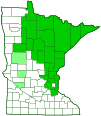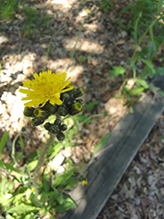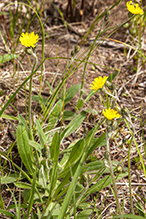meadow hawkweed
(Pilosella caespitosa)
Conservation • Weed • Description • Habitat • Ecology • Use • Distribution • Taxonomy
|
|
|||||||||||||||||||
Description |
Meadow hawkweed is an exotic, weedy, flowering plant. It is native to parts of Europe and to Azerbaijan. It was introduced and is now naturalized throughout the rest of Europe, in North America, and in New Zealand. It was first discovered in the United States in Washington State in 1969. Since then, it has spread widely. It now occurs in the west from Washington to northern Oregon, east to western Montana and northern Colorado. In the east it occurs from Maine to Virginia, west to Minnesota and Illinois, and south along the Appalachian Mountains to northern Georgia. Meadow hawkweed is found on stream sides and in open, disturbed sites, including pastures, abandoned fields, vacant lots, parks, and roadsides. It grows under full or partial sun, in moderately moist to dry conditions, in sandy soil. Meadow hawkweed is an 8″ to 29½″ (20 to 75 cm) tall, erect, perennial forb that rises on a rosette of basal leaves and usually a single stem from a short to long, spreading rhizome. It frequently forms colonies. The entire plant is covered with a complex mixture of hairs. Like other hawkweeds, the hairiness includes several types of hairs in different combinations on different parts of the plant. The stem is unbranched, pale green, and round. The lower stem is moderately to densely covered with light orangish brown, spreading to ascending, 1⁄32″ to ⅛″ (1 to 3 mm) long hairs. These hairs have a bulbous or slightly expanded base. It is also moderately to densely covered with blackish, gland tipped hairs. It is sometimes also covered with inconspicuous, minute, branched hairs. The branched hairs may appear star shaped and are often called “star-shaped hairs.” However, they are seldom truly star shaped, and they will be referred to here as “minute branched hairs.” Toward the top of the stem, the gland-tipped hairs and the minute branched hairs become more dense. The spreading hairs toward the top are 1⁄32″ to ⅛″ (1 to 4 mm) long, but they are sparse or they disappear altogether. There are 3 to 8 or more basal leaves, and they are persistent at flowering time. They are stalkless or are attached to a short, indistinct, winged stalk. The leaf blades are narrowly inversely lance shaped, wedge shaped at the base, and sharply pointed at the tip. They are usually 1⅜″ to 4¾″ (35 to 120 mm) long and ½″ to ¾″ (12 to 20 mm) wide, but they are sometimes much longer and sometimes much wider. The margins are untoothed. The upper and lower surfaces are usually hairy, sometimes hairless. When hairy, they are moderately to densely covered with spreading, 1⁄32″ to ⅛″ (1 to 3 mm) long hairs. These hairs have a bulbous base, and they are often relatively dark colored. The surfaces are also sparsely to moderately covered with minute branched hairs. There are usually only 1 or 2 stem leaves. These leaves are alternate, mostly stalkless, and near the stem base. The blades are narrowly lance shaped to linear. The base of the blades does not partially surround (clasp) the stem. They are shorter but otherwise similar to basal leaves. The inflorescence is 5 to 25 or more flower heads at the end of the stem. They are sometimes in a short, spreading, branched cluster (panicle), but they are more often in a compact, umbrella-like (umbelliform) cluster or a dense, flat or convex (corymbiform) cluster. The flowers bloom from late May to early July. At the base of each flower head there is a bell shaped, ¼″ to ⅜″ (6 to 9 mm) long whorl (involucre) of 12 to 18 or more bracts (phyllaries) in two series. The phyllaries in the inner series are narrowly oblong elliptic. The tips are pointed, with either straight or convex sides along the tip. The outer surface is covered with soft, 1⁄32″ to 3⁄32″ (1.0 to 2.5 mm) long hairs; with minute, cobwebby, branched hairs; and with dark, gland-tipped hairs. The outer series of phyllaries are similar but much shorter, though some are more than half as long as the inner series. Each flower has 25 to 50 or more bright yellow ray florets and no disc florets. The ray florets are linear oblong and 5⁄16″ to 9⁄16″ (8 to 14 mm) long. They have 5 teeth at the tip. The fruit is a dry seed capsule (cypsela) with a single seed inside. The cypsela is 1⁄16″ (1.5 to 1.8 mm) long and column shaped, more or less cylindrical and not tapered at the end. There are 25 to 30 or more bristles (pappi) at the tip. The pappi are white and ⅛″ to ¼″ (4 to 6 mm) long. |
Height |
8″ to 29½″ (20 to 75 cm) |
Flower Color |
Bright yellow |
Similar Species |
Habitat |
Moderately moist to dry. Stream sides, pastures, abandoned fields, vacant lots, parks, and roadsides. Full or partial sun. Sandy soil. |
Ecology |
Flowering |
Late May to early July |
Pests and Diseases |
|
Use |
|
Distribution |
||
|
Sources 2, 3, 4, 5, 7, 22, 24, 28, 29, 30. The map includes unverified records in western Minnesota counties from iNaturalist (light green on the map). |
|
| 7/24/2024 | ||
Nativity |
||
Native to Europe. Introduced and naturalized in North America. |
||
Occurrence |
||
Common |
||
Taxonomy |
|
| Kingdom | Plantae (Plants) |
| Phylum | Tracheophyta (Vascular Plants) |
| Subdivision | Spermatophytina (Seed Plants) |
| Class | Magnoliopsida (Dicots) |
Order |
Asterales (Sunflowers, Bellflowers, Fanflowers, and Allies) |
Family |
Asteraceae (Sunflowers, Daisies, Asters, and Allies) |
| Subfamily | Cichorioideae (chicories, dandelions, and allies) |
| Tribe | Cichorieae (lettuce, chicory, dandelion, and salsify) |
| Subtribe | Hieraciinae (hawkweeds) |
| Genus | Pilosella (mouse-ear hawkweeds) |
Until recently, plants in the genus Pilosella were grouped as a subgenus of Hieracium. Distinct features of the cypsela, absence of hybridization between groups, and, in some species, the presence of runners (stolons) and/or red lines on the lower (abaxial) ligule surface, support the segregation of these species into a separate genus. Not all sources accept the split. GRIN, GBIF, NCBI, Plants of the World Online, World Flora Online, and iNaturalist have adopted the new name Pilosella caespitosa. USDA PLANTS, NatureServe, and Flora of North America continue to use the old name Hieracium caespitosum. |
|
Subordinate Taxa |
|
meadow hawkweed (Pilosella caespitosa ssp. caespitosa) meadow hawkweed (Pilosella caespitosa ssp. colliniformis) |
|
Synonyms |
|
Hieracium caespitosum Hieracium pratense |
|
Common Names |
|
field hawkweed meadow hawkweed yellow hawkweed yellow king-devil |
|
Glossary
Clasping
Describing a leaf that wholly or partly surrounds the stem but does not fuse at the base.
Corymb
A flat-topped or convex inflorescence in which the stalked flowers grow upward from various points on the main stem to approximately the same horizontal plane. The outer flowers open first.
Cypsela
A dry, one-chambered, single-seeded seed capsule, formed from a single carpel, with the seed attached to the membranous outer layer (wall) only by the seed stalk; the wall, formed from the wall of the inferior ovary and also from other tissues derived from the receptacle or hypanthium, does not split open at maturity, but relies on decay or predation to release the contents.
Involucre
A whorl of bracts beneath or surrounding a flower, flower head, or flower cluster.
Linear
Long, straight, and narrow, with more or less parallel sides, like a blade of grass.
Panicle
A pyramidal inflorescence with a main stem and branches. Flowers on the lower, longer branches mature earlier than those on the shorter, upper ones.
Pappus
The modified calyx composed of awns, scales, bristles, or feather-like hairs in plants of the Asteraceae family.
Phyllary
An individual bract within the involucre of a plant in the Asteraceae family.
Pubescent
Covered with soft, fine, short hairs. Also used as a general term meaning covered hairs.
Rhizome
A horizontal, usually underground stem. It serves as a reproductive structure, producing roots below and shoots above at the nodes.
Umbel
A flat-topped or convex, umbrella-shaped cluster of flowers or buds arising from more or less a single point.
Complexly pubescent
The hairiness (pubescence) of hawkweeds is a complex mixture several types of hairs in different combinations on diferent parts of the plant.
Visitor Photos |
||
Share your photo of this plant. |
||
This button not working for you? |
||
Alfredo Colon |
 |
Luciearl |
||
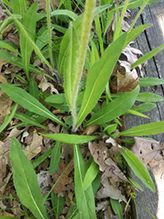 |
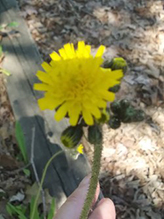 |
|
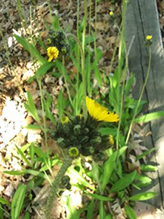 |
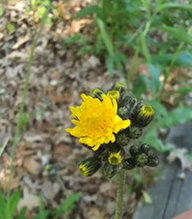 |
|
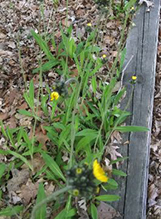 |
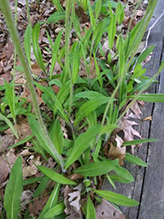 |
|
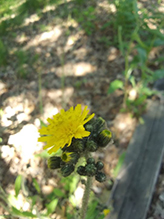 |
||
MinnesotaSeasons.com Photos |
||
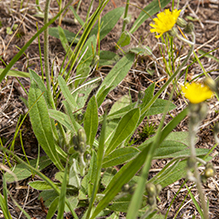 |
||
Plant |
Plant | |
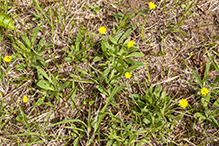 |
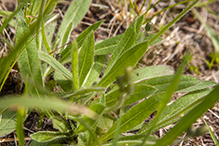 |
|
Plants |
Leaves | |
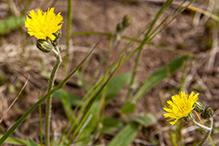 |
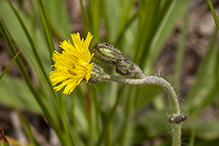 |
|
Inflorescence |
Inflorescence | |
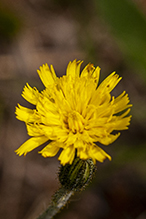 |
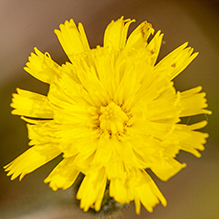 |
|
Flower head |
Flower head | |
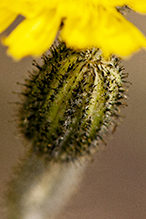 |
||
| Involucre |
|

Slideshows |
|

Visitor Videos |
||
Share your video of this plant. |
||
This button not working for you? |
||
|
Other Videos |
||
Pilosella caespitosa, Hieracium caespitosum, meadow hawkweed, yellow hawkweed, field hawkweed |
About
May 5, 2019 I go through the forests, mountains, hills, fields, and waters to understand the living world and to create a living mind. Pilosella caespitosa, Hieracium caespitosum, meadow hawkweed, yellow hawkweed, field hawkweed, king devil, yellow paintbrush, devil's paintbrush |
Meadow Hawkweed , Field Hawkweed, Hieracium caespitosum, Pilosella caespitosaIMG 5360 |
About
Jun 21, 2019 |

|
Created: 7/25/2024 Last Updated: © MinnesotaSeasons.com. All rights reserved. |
